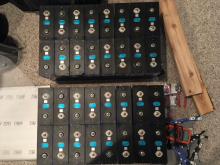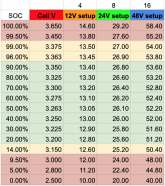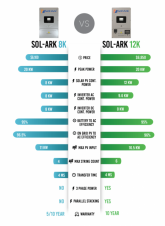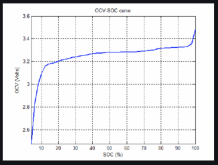I've been looking hard at the Treeline LiFePO4 batteries for my new 15kW PV system. Do you have yours installed yet, and if so, what are your early thoughts on performance, etc.? Thanks.
I have not had a chance to test them out yet. However, he lists the warranty as follows on performance:
"Three years warranty on components and 7 year performance warranty >80% capacity. "
So I believe it was a decent deal on them, the only thing that was a bit frustrating was since then, I learned that clamping batteries with aluminum plates helps to keep cells from potentially bulging and can help them to get longest cycles. But the Treeline packs I got were all stuck together with double-sided foam tape strips. So if I had known about the clamps thing, I would've simply asked Treeline to assemble, test, and disassemble my pack, and not stick the cells together with the tape, because I had to spend hours with Goo-Gone and remove the tape so they are clean cells, and will sit flat together. So before you bought them, I would ping Randy and just tell if if you want them stuck together or if you plan to clamp them, then don't use the tape.
The only other things, I bought mine with the 200a 16s BMS, and they are fine, they look really heavy duty, made by a Chine company called Bellhope Technologies Ltd. I think they are these ones:
Smarter Shopping, Better Living! Aliexpress.com

www.aliexpress.com
无锡百虹科技有限公司是一家研发,生产,销售动力锂电池保护板,电动车保护板,园林工具无刷控制器及充电器解决方案为一体的高科技企业,本公司本着人才,追求品质,正道经营,共存共赢的企业宗旨。
www.bellhope.com
They seem good enough for a basic high current BMS, I have 2 of them, 16s for each of 2 battery banks (32 cells total), which I will parallel together. The only thing is, these are un-managed BMS's so no bluetooth smartphone app to do cell level monitoring.
So I am adding in a set of active balancers which offer a bluetooth smartphone app function, where I can at least get cell level voltage monitoring (I'm the type which likes to be able to login and check up on them if I want to once in awhile):
Find many great new & used options and get the best deals for Li-ion Lipo Lifepo4 LTO Battery Active Equalizer 2S-24S BMS APP 2A Balancer NEW at the best online prices at eBay! Free shipping for many products!
www.ebay.com
Just to note, the Treeline 200a Bellhope BMS do have passive balancing on discharge, so for me, I basically thought the enhancement to active balancer is just a bell/whistle more to give me cell level app monitoring of voltages, since the Bellhope are a 'dumb' BMS...
I am happy with the purchase I suppose, since he does offer advance replacement so if a cell goes bad he can ship replacements right away. My next battery bank I'm building for my RV is a 12v, 4s2p (8 cells), w/ 2x Overkill 120a BMS. Buying raw cells from China cuts the cost in half. (but I am still waiting to receive my shipment on those since Oct 23rd, as it's super slow). I got the Overkill BMS's though (as they are sold in US), they look good offer app level smartphone BMS management, can adjust BMS parameters, etc. They only sell those up to 120a though.
So I've learned some things here, not saying any way is better than the other, I guess it depends on your goals, what you want to spend, how soon you need the solution, etc... Treeline did ship these packs pretty fast though.
Anyways, here is a picture of the Treeline cells (I have all the bus bars off, and nothing connected), they just look like a lot of the EVE-style copys or whatever, or maybe these are EVE, I have no idea where they came from, and those are the BMS's down in the bottom right corner:













